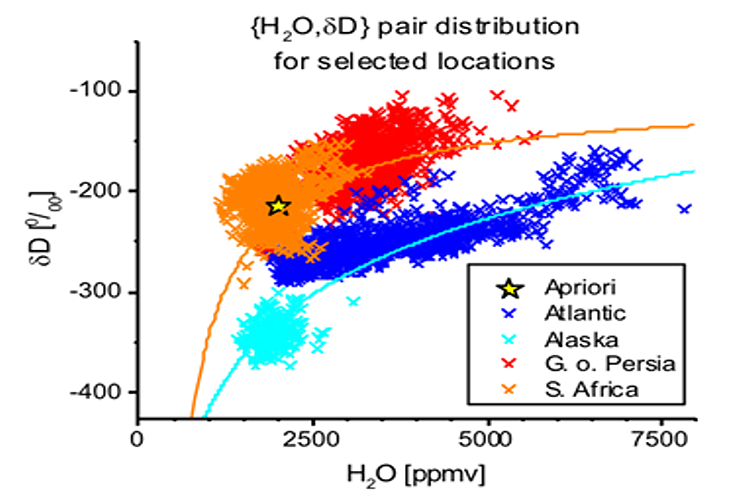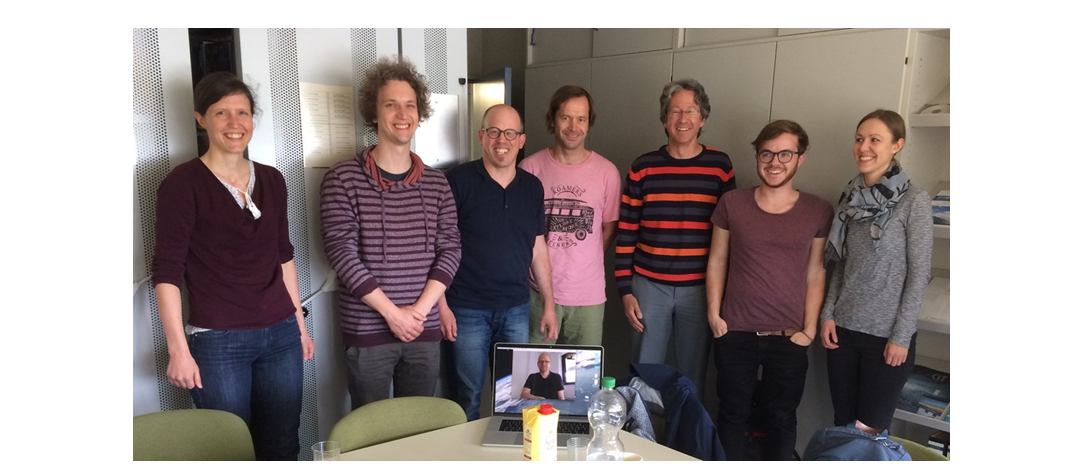Tracing water over Africa
Water is arguably the most important element for life on Earth. Water is evaporated from the world’s oceans or transpired by plants, it is transported around the globe, condensates or freezes in clouds, falls out as rain or snow, evaporates in the air or reaches the ground as precipitation. Modelling this so-called atmospheric branch of the hydrological cycle in all detail is still a challenge, even for very large computers. One of the unresolved problems in this context is the fact that when we measure water vapour in the atmosphere, we can determine its amount but not where it came from, making it hard to identify errors in water transports or phase transitions in our models.
| Fig.1: Water vapour (H2O)–δD pair distributions observed from satellite in four different regions. The solid cyan and orange lines are example curves for drying by rain out (expected for the Atlantic and Alaska) and by mixing with dry air (expected for the Gulf of Persia and South Africa). |
One possible solution to this problem is to determine the relatively small content of “heavy” water isotopologues, i.e. water molecules that contain heavier than normal hydrogen or oxygen atoms (e.g. expressed by δD, see Figure 1). This content depends on many factors such as the water temperature at evaporation or phase changes in the atmosphere and therefore gives hints about the provenance of the water. Such approaches have long been used to analyse rainwater or ice cores, but more recently instruments have been developed to measure isotopologues in the gas phase and to sense it remotely from the ground or even from satellites. In addition, water isotopologues have been implemented into weather and climate models for a better comparison with the increasing number of measurements.
The recently started project MOTIV (MOisture Transport pathways and Isotopologues in water Vapour), funded jointly by the German Research Foundation and the Swiss National Fund and led by Dr. Matthias Schneider, uses this powerful new approach to better assess reasons for errors in water transport or precipitation in the weather forecast models of the German Weather Service. The project brings together experts in atmospheric dynamics, computer modelling, remote sensing and informatics. Within KIT it involves members of two IMK Departments, TRO and ASF, as well as the Steinbuch Center for Computing plus external collaborators from ETH Zurich and the Free University Berlin.
| Fig.2: Members of MOTIV at the first project meeting in Karlsruhe on 16 May 2018. From left: Franziska Aemisegger (ETHZ), Benjamin Ertl (SCC), Peter Knippertz (IMK-TRO), Matthias Schneider (IMK-ASF), Heini Wernli (ETHZ), Christopher Diekmann (IMK-ASF), Fabienne Dahinden (ETHZ), Stephan Pfahl (FUB, via Skype). |
Due to the long-standing expertise in tropical meteorology in IMK-TRO’s Working Group “Atmospheric Dynamics” led by Prof. Dr. Peter Knippertz one focus of the investigations is the region of the West African monsoon. This large atmospheric circulation system is notoriously hard to model, leading to unreliable weather prediction and low confidence in climate projections. It has long been suspected that substantial amounts of water coming in from the tropical Atlantic are “recycled” by precipitation and re-evaporation but this has never been demonstrated quantitatively. Other badly understood processes include the vertical transport of water by large thunderstorm complexes and by dry thermals over the hot Sahara desert. “MOTIV provides a whole new perspective on many factors determining the hydrological cycle”, says Knippertz, “and we are very excited to see the first results from our modelling and satellite data analysis.”
[Working group: Atmospheric Dynamics]


